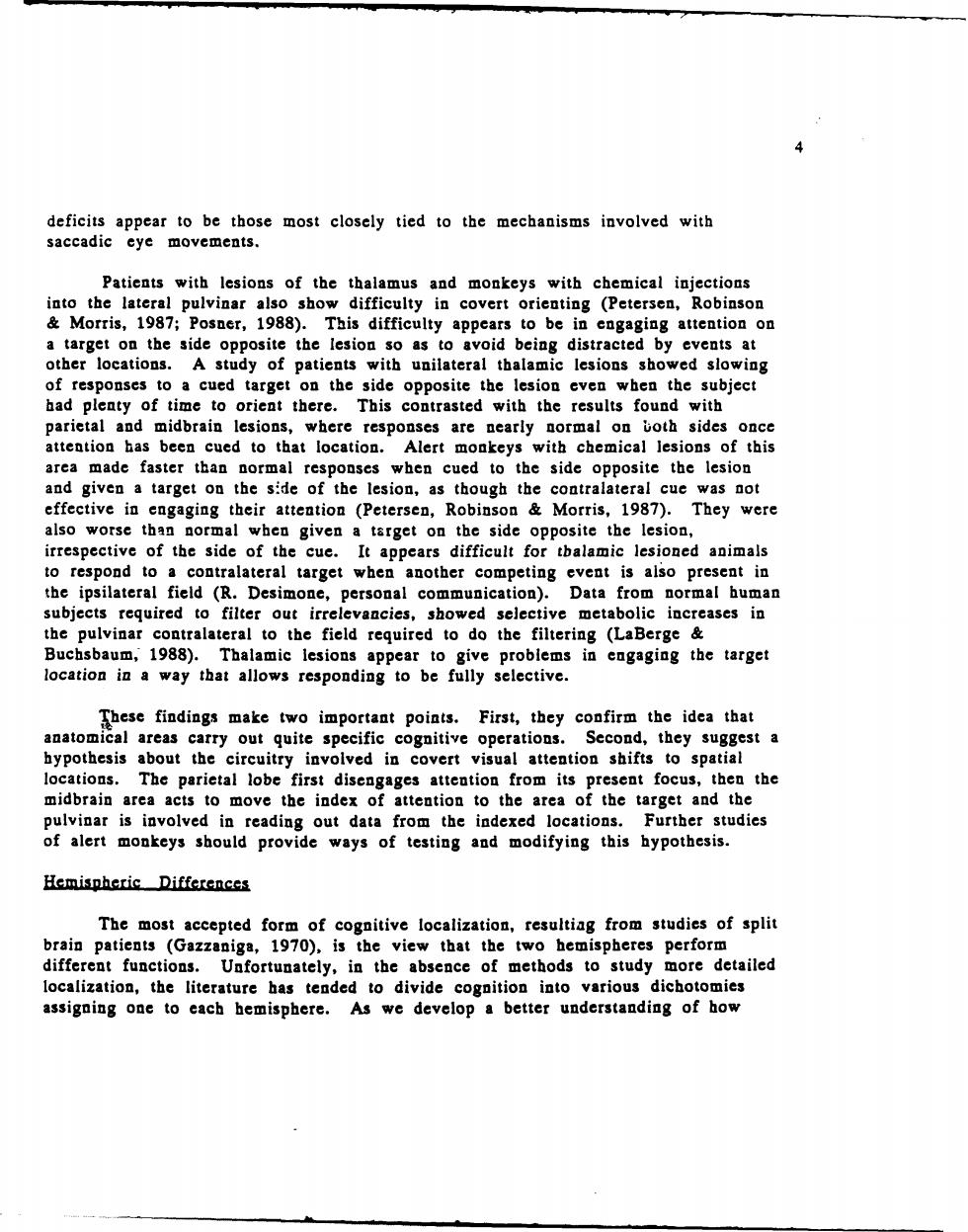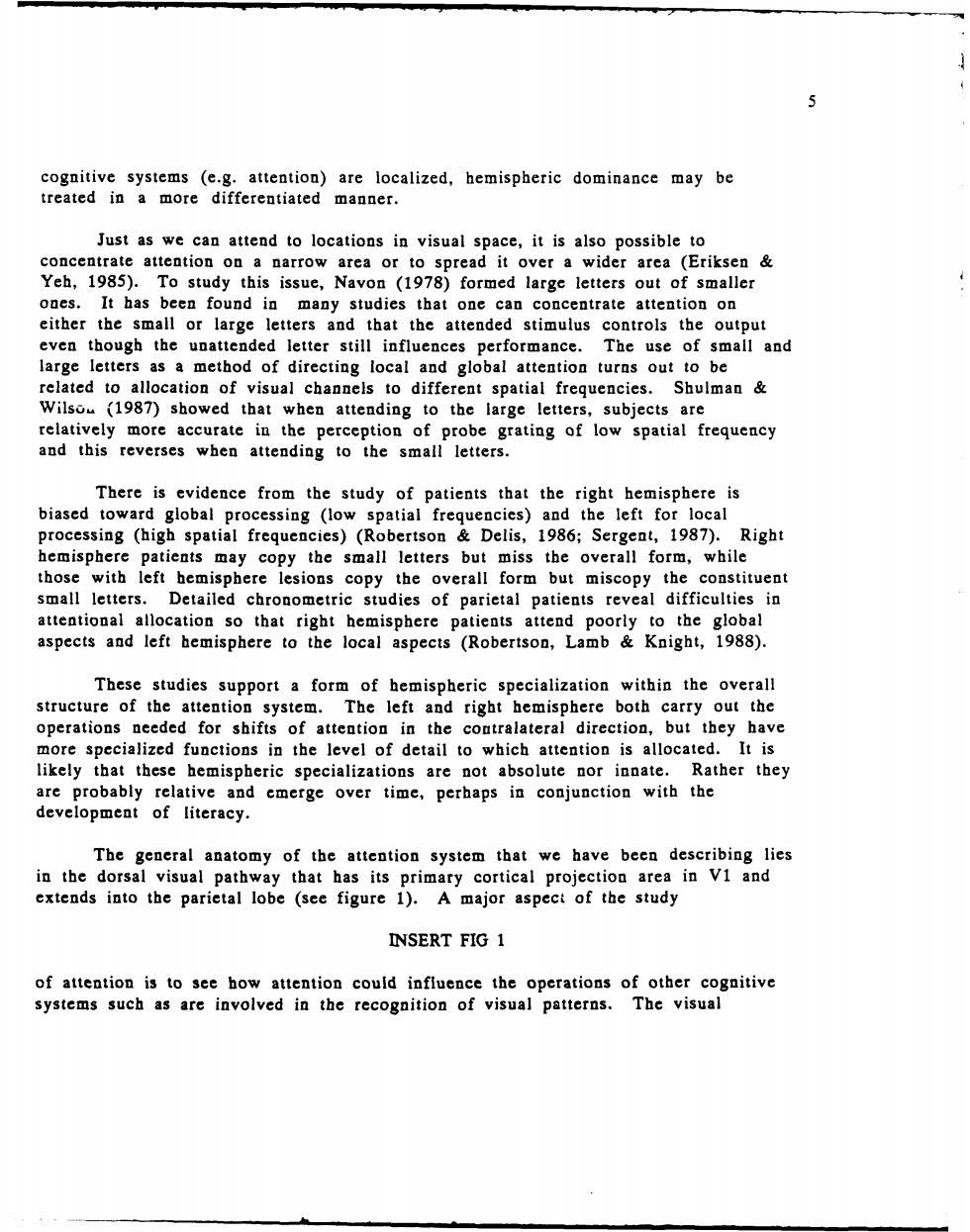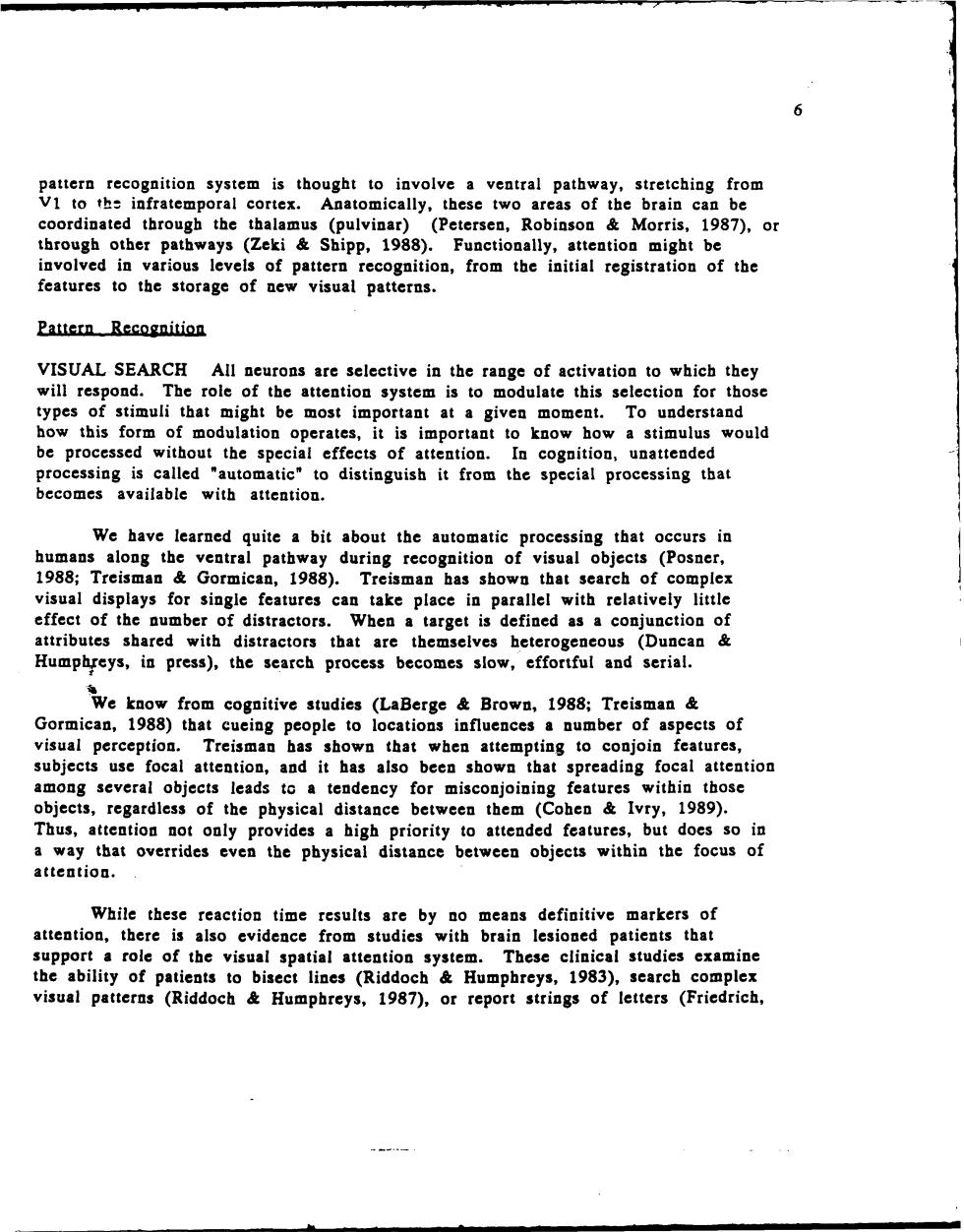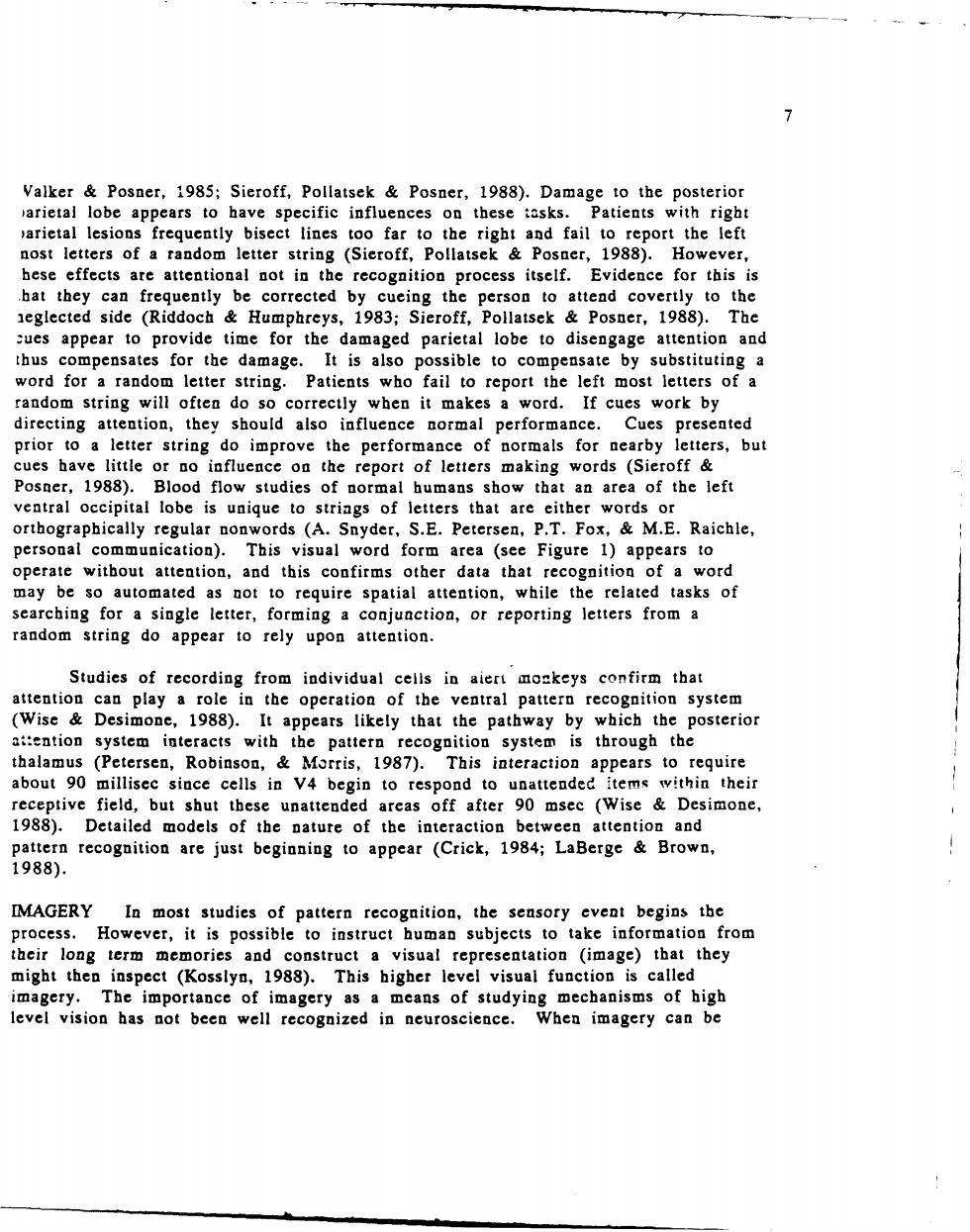
deficits appear to be those most closely tied to the mechanisms involved with saccadic eye movements. Patients with lesions of the thalamus and monkeys with chemical injections into the lateral pulvinar also show difficulty in covert orienting (Petersen,Robinson Morris,1987;Posner,1988).This difficulty appears to be in engaging attention on a target on the side opposite the lesion so as to avoid being distracted by events at other locations.A study of patients with unilateral thalamic lesions showed slowing of responses to a cued target on the side opposite the lesion even when the subject had plenty of time to orient there.This contrasted with the results found with parietal and midbrain lesions,where responses are nearly normal on both sides once attention has been cued to that location.Alert monkeys with chemical lesions of this area made faster than normal responses when cued to the side opposite the lesion and given a target on the side of the lesion,as though the contralateral cue was not effective in engaging their attention (Petersen,Robinson Morris,1987).They were also worse than normal when given a tsrget on the side opposite the lesion, irrespective of the side of the cue.It appears difficult for tbalamic lesioned animals to respond to a contralateral target when another competing event is also present in the ipsilateral field (R.Desimone,personal communication).Data from normal buman subjects required to filter out irrelevancies,showed selective metabolic increases in the pulvinar contralateral to the field required to do the filtering (LaBerge Buchsbaum,1988). Thalamic lesions appear to give probiems in engaging the target location in a way that allows responding to be fully selective. First,they confirm the idea that areas ca sis rry out quite speci cognitive operations try ved in covert attention shifts to spat midb The parietal lobe first 03, the the move the index of attentio the the targe and ar is lnvolve out data studies ler monkeys should provide ways of testing and modifying this The most accepted fo diffe 8a, 9 ately etailed 100 re to div we develop a aee erst nding of how
4 deficits appear to be those most closely tied to the mechanisms involved with saccadic eye movements. Patients with lesions of the thalamus and monkeys with chemical injections into the lateral pulvinar also show difficulty in covert orienting (Petersen, Robinson & Morris, 1987; Posner, 1988). This difficulty appears to be in engaging attention on a target on the side opposite the lesion so as to avoid being distracted by events at other locations. A study of patients with unilateral thalamic lesions showed slowing of responses to a cued target on the side opposite the lesion even when the subject had plenty of time to orient there. This contrasted with the results found with parietal and midbrain lesions, where responses are nearly normal on both sides once attention has been cued to that location. Alert monkeys with chemical lesions of this area made faster than normal responses when cued to the side opposite the lesion and given a target on the s:de of the lesion, as though the contralateral cue was not effective in engaging their attention (Petersen, Robinson & Morris, 1987). They were also worse than normal when given a target on the side opposite the lesion, irrespective of the side of the cue. It appears difficult for tbalamic lesioned animals to respond to a contralateral target when another competing event is also present in the ipsilateral field (R. Desimone, personal communication). Data from normal human subjects required to filter out irrelevancies, showed selective metabolic increases in the pulvinar contralateral to the field required to do the filtering (LaBerge & Buchsbaum. 1988). Thalamic lesions appear to give problems in engaging the target location in a way that allows responding to be fully selective. These findings make two important points. First, they confirm the idea that anatomical areas carry out quite specific cognitive operations. Second, they suggest a hypothesis about the circuitry involved in covert visual attention shifts to spatial locations. The parietal lobe first disengages attention from its present focus, then the midbrain area acts to move the index of attention to the area of the target and the pulvinar is involved in reading out data from the indexed locations. Further studies of alert monkeys should provide ways of testing and modifying this hypothesis. Hemispheric Differences The most accepted form of cognitive localization, resultiag from studies of split brain patients (Gazzaniga, 1970), is the view that the two hemispheres perform different functions. Unfortunately, in the absence of methods to study more detailed localization, the literature has tended to divide cognition into various dichotomies assigning one to each hemisphere. As we develop a better understanding of how

5 cognitive systems (e.g.attention)are localized,hemispheric dominance may be treated in a more differentiated manner. Just as we can attend to locations in visual space,it is also possible to concentrate attention on a narrow area or to spread it over a wider area(Eriksen Yeh,1985). To study this issue,Navon (1978)formed large letters out of smaller ones.It has been found in many studies that one can concentrate attention on either the small or large letters and that the attended stimulus controls the output even though the unattended letter still influences performance.The use of small and large letters as a method of directing local and global attention turns out to be related to allocation of visual channels to different spatial frequencies.Shulman& Wilso(1987)showed that when attending to the large letters,subjects are relatively more accurate in the perception of probe grating of low spatial frequency and this reverses when attending to the small letters. There is evidence from the study of patients that the right hemisphere is biased toward global processing (low spatial frequencies)and the left for local processing (high spatial frequencies)(Robertson Delis,1986;Sergent,1987).Right hemisphere patients may copy the small letters but miss the overall form,while those with left hemisphere lesions copy the overall form but miscopy the constituent small letters.Detailed chronometric studies of parietal patients reveal difficulties in attentional allocation so that right hemisphere patients attend poorly to the global aspects and left hemisphere to the local aspects (Robertson,Lamb Knight,1988). These studies support a form of hemispheric specialization within the overall structure of the attention system.The left and right hemisphere both carry out the operations needed for shifts of attention in the coutralateral direction.but they have more specialized functions in the level of detail to which attention is allocated.It is likely that these hemis ecializations are not absolute Rather they are probably relative nd cmerge over time,perhaps in conjunction with the development of literacy. my of the atter system tha we have been describing lies in the do isual pat primary proje a in v1 and extends into the parietal lobe (sce figure 1). A major aspeci INSERT FIG 1 the operations of other cognitive visual patterns. visua
5 cognitive systems (e.g. attention) are localized, hemispheric dominance may be treated in a more differentiated manner. Just as we can attend to locations in visual space, it is also possible to concentrate attention on a narrow area or to spread it over a wider area (Eriksen & Yeh, 1985). To study this issue, Navon (1978) formed large letters out of smaller ones. It has been found in many studies that one can concentrate attention on either the small or large letters and that the attended stimulus controls the output even though the unattended letter still influences performance. The use of small and large letters as a method of directing local and global attention turns out to be related to allocation of visual channels to different spatial frequencies. Shulman & Wilson. (1987) showed that when attending to the large letters, subjects are relatively more accurate in the perception of probe grating of low spatial frequency and this reverses when attending to the small letters. There is evidence from the study of patients that the right hemisphere is biased toward global processing (low spatial frequencies) and the left for local processing (high spatial frequencies) (Robertson & Delis, 1986; Sergent, 1987). Right hemisphere patients may copy the small letters but miss the overall form, while those with left hemisphere lesions copy the overall form but miscopy the constituent small letters. Detailed chronometric studies of parietal patients reveal difficulties in attentional allocation so that right hemisphere patients attend poorly to the global aspects and left hemisphere to the local aspects (Robertson, Lamb & Knight, 1988). These studies support a form of hemispheric specialization within the overall structure of the attention system. The left and right hemisphere both carry out the operations needed for shifts of attention in the contralateral direction, but they have more specialized functions in the level of detail to which attention is allocated. It is likely that these hemispheric specializations are not absolute nor innate. Rather they are probably relative and emerge over time, perhaps in conjunction with the development of literacy. The general anatomy of the attention system that we have been describing lies in the dorsal visual pathway that has its primary cortical projection area in V1 and extends into the parietal lobe (see figure 1). A major aspect of the study INSERT FIG 1 of attention is to see how attention could influence the operations of other cognitive systems such as are involved in the recognition of visual patterns. The visual

6 ttern reco is thou thes coordinated through the thalamus (pulvinar) (Peterser Robinson Mo 3,1987).or through other pathways (Zeki&Shipp 10只g1 Hh2aEoHo074oa2x22ae7CAm0nPR0A attention t be istration of the features to the storage of new visual patterns. Pattern recognition ARou All neurons are selectve in the range of activation to will respond.The role of the att is to m dulate this selection for those might be most imp nt To understand it is im how a stim ulus would be processed without the special effects of att In c nition,unattended 8ceGoengnedagomioantsiagahtoaac cial processing that We have learned quite a bit about the automatic processing that occurs in humans along the ventral patbway during recognition of visual objects (Posner 1988;Treisman Gormican,1988). Treisman has sho、 n that tearch of comnle visual displays for single features can take place in arallel with relatively little effect of the number of distract When a tar et is defined as a conjunction of attributes shared with distractors that are ther (Duncan Humphpeys,in press),the search process becomes slow,efforful and serial. We kaow from cognitive studies (LaBerge&Brown,198:Treisman Gormican,1988)that cu ple to locatic ces a number of aspects of visual perception. has shown that when attempting to e subjects use focal attention. and it has also beer sho hat spreading focal attention among several obiects leads to mis features within those obiects.r egardless of the ical distan .h y (Cohe &Iv ,1989). only pro t does so in a wav that de even the physical distance hin the focus of attenti a. While these reaction time results are by definitive eviden ies with of vis his att amine visual Riddo nes (Ri Humphreys,1987),or report strings of
6 pattern recognition system is thought to involve a ventral pathway, stretching from V1 to th: infratemporal cortex. Anatomically, these two areas of the brain can be coordinated through the thalamus (pulvinar) (Petersen, Robinson & Morris, 1987), or through other pathways (Zeki & Shipp, 1988). Functionally, attention might be involved in various levels of pattern recognition, from the initial registration of the features to the storage of new visual patterns. Pattern Recoanition VISUAL SEARCH All neurons are selective in the range of activation to which they will respond. The role of the attention system is to modulate this selection for those types of stimuli that might be most important at a given moment. To understand how this form of modulation operates, it is important to know how a stimulus would be processed without the special effects of attention. In cognition, unattended processing is called "automatic" to distinguish it from the special processing that becomes available with attention. We have learned quite a bit about the automatic processing that occurs in humans along the ventral pathway during recognition of visual objects (Posner, 1988; Treisman & Gormican, 1988). Treisman has shown that search of complex visual displays for single features can take place in parallel with relatively little effect of the number of distractors. When a target is defined as a conjunction of attributes shared with distractors that are themselves heterogeneous (Duncan & Humph reys, in press), the search process becomes slow, effortful and serial. We know from cognitive studies (LaBerge & Brown, 1988; Treisman & Gormican, 1988) that cueing people to locations influences a number of aspects of visual perception. Treisman has shown that when attempting to conjoin features, subjects use focal attention, and it has also been shown that spreading focal attention among several objects leads to a tendency for misconjoining features within those objects, regardless of the physical distance between them (Cohen & Ivry, 1989). Thus, attention not only provides a high priority to attended features, but does so in a way that overrides even the physical distance between objects within the focus of attention. While these reaction time results are by no means definitive markers of attention, there is also evidence from studies with brain lesioned patients that support a role of the visual spatial attention system. These clinical studies examine the ability of patients to bisect lines (Riddoch & Humphreys, 1983), search complex visual patterns (Riddoch & Humphreys, 1987), or report strings of letters (Friedrich

Valker Posner,1985;Sieroff,Pollatsek Posner,1988).Damage to the posterior arietal lobe appears to have specific influences on these tasks. Patients with rigbt parietal lesions frequently bisect lines far to the right and fail to report the left nost letters of a tandom letter string (Sieroff,Pollatsek Posner,1988).However. hese effects are attentional not in the recognition process itself.Evidence for this is hat they can frequently be corrected by cueing the person to attend covertly to the neglected side (Riddoch Humphreys,1983:Sieroff,Pollatsek Posner,1988).The cues appear to provide time for the damaged parietal lobe to disengage attention and thus e pensates for the damage It is also ssible to substituting word for a random letter Patients ho fail to report the left most letters of a tring will do it o ord by should etter d mpro per TS, but uen 1988). report letters of n area left le y & ME Raichle, a Figure with oper 6 ut this contirm tha not to require spatial att sks of rching single letter,forming a conjunct or reporting letters from a random string do appear to rely upon attention. Studies of recording from individual cells in aiert mokeys confirm that attent can play a role in the operation of the ventral pattern recognition system (Wise Desimone,1988).It appears likely that the pathway by which the posterior aiention system interacts with the pattern recognition system is through the thalamus (Petersen,Robinson,Morris,1987).This interaction appears to require about 90 millisec since cells in v4 begin to respond to unattended items within their receptive field,but shut these unattended areas off after 90 msec (Wise Desimone. 1988).Detailed models of the nature of the interaction between attention and pattern recognition are just beginning to appear (Crick,1984;LaBerge Brown, 1988). [MAGERY In most studies of pattern recognition,the sensory event begins the process.However,it is possible to instruct human subjects to take information from their long term memories and construct a visual representation (image)that they might then inspect (Kosslyn,1988).This bigher level visual function is called imagery.The importance of imagery as a means of studying mechanisms of high level vision has not been well recognized in neuroscience. When imagery can be
7 Valker & Posner, 1985; Sieroff, Pollatsek & Posner, 1988). Damage to the posterior )arietal lobe appears to have specific influences on these tasks. Patients with right )arietal lesions frequently bisect lines too far to the right and fail to report the left nost letters of a random letter string (Sieroff, Pollatsek & Posner, 1988). However, hese effects are attentional not in the recognition process itself. Evidence for this is hat they can frequently be corrected by cueing the person to attend covertly to the ,eglected side (Riddoch & Humphreys, 1983; Sieroff, Pollatsek & Posner, 1988). The :ues appear to provide time for the damaged parietal lobe to disengage attention and thus compensates for the damage. It is also possible to compensate by substituting a word for a random letter string. Patients who fail to report the left most letters of a random string will often do so correctly when it makes a word. If cues work by directing attention, they should also influence normal performance. Cues presented prior to a letter string do improve the performance of normals for nearby letters, but cues have little or no influence on the report of letters making words (Sieroff & Posner, 1988). Blood flow studies of normal humans show that an area of the left ventral occipital lobe is unique to strings of letters that are either words or orthographically regular nonwords (A. Snyder, S.E. Petersen, P.T. Fox, & M.E. Raichle, personal communication). This visual word form area (see Figure 1) appears to operate without attention, and this confirms other data that recognition of a word may be so automated as not to require spatial attention, while the related tasks of searching for a single letter, forming a conjunction, or reporting letters from a random string do appear to rely upon attention. Studies of recording from individual cells in aiert monkeys confirm that attention can play a role in the operation of the ventral pattern recognition system (Wise & Desimone, 1988). It appears likely that the pathway by which the posterior a.:ention system interacts with the pattern recognition systew is through the thalamus (Petersen, Robinson, & Morris, 1987). This interaction appears to require about 90 millisec since cells in V4 begin to respond to unattended ltermq within their receptive field, but shut these unattended areas off after 90 msec (Wise & Desimone, 1988). Detailed models of the nature of the interaction between attention and pattern recognition are just beginning to appear (Crick, 1984; LaBerge & Brown, 1988). IMAGERY In most studies of pattern recognition, the sensory event begins the process. However, it is possible to instruct human subjects to take information from their long term memories and construct a visual representation (image) that they might then inspect (Kosslyn, 1988). This higher level visual function is called imagery. The importance of imagery as a means of studying mechanisms of high level vision has not been well recognized in neuroscience. When imagery can be

8 ployed as a means of studying vision,it allows more direct access to the higher vels of information processing without contamination from lower levels.There is considerable evidence that some of the same anatomical mechanisms are imagery as are involved in some aspects of pattern recognition (Farab,1988; osslyn,1988). Patients with right parietal lesions,who show deficits in visual ienting of the type we have described above,also fail to report the ntrales of visual images (Bisiach,Luzzatti Perani,1981).Whea asked a a nc, they make elaborate reports of the right side but not the :glecte paris of the are reported when facing in one direction are This suggests that the deficit arises at the time scanning the image rmal sub) imag ine the selves ing on fami route, blood activa up parieta (Roland, 85) ug study.m of ghts the pe 10 gery. 93 previously,the o pa terna ati pcoselytela involved attend ing to an external location when subjects scan a visual image NTERIOR ATTENTION SYSTEM ber paper on the topog of」 cogni a-Rakic (1988) de lob cribes medial and tex alled appe olu -ur1a1973 ave called the posterior attention system,to focs g by conscious attention Cognitive ave ofter shown tha detec 78. It haa oduces little curs (Duncan 10g ral aler ate.and one in which d the h ttle trouble in he ultiple pro modalities of interfer The of he widespread erference the de ys hat there unified 4 system
8 iployed as a means of studying vision, it allows more direct access to the higher vels of information processing without contamination from lower levels. There is now considerable evidence that some of the same anatomical mechanisms are ed in imagery as are involved in some aspects of pattern recognition (Farah, 1988; 3sslyn, 1988). Patients with right parietal lesions, who show deficits in visual ienting of the type that we have described above, also fail to report the intralesional side of visual images (Bisiach, Luzzatti & Perani, 1981). When asked imagine a familiar scene, they make elaborate reports of the right side but not the ft. The parts of the image that are reported when facing in one direction are -glected when facing in the other. This suggests that the deficit arises at the time scanning the image. When normal subjects imagine themselves walking on a familiar route, blood ow studies show activation of the superior parietal lobe on both sides (Roland, ?85). Although many other areas of the brain are also active in this study, most of tern are common to other verbal and arithmetical thoughts, but activation of the iperior parietal lobe seems more unique to imagery. As discussed previously, the arietal lobe seems to be central to spatial attention to external locations. Thus, it ppears likely that the neural systems involved in attending to an external location re closely related to those used when subjects scan a visual image. ,NTERIOR ATTENTION SYSTEM In her paper on the topography of cognition, Goldman-Rakic (1988) describes le strong connectionb between the posterior parietal lobe and areas of the lateral ad medial frontal cortex. This anatomical organization is appealing as a basis for elating what has been called involuntary orienting by Luria (1973), and what we ave called the posterior attention system, to focal or conscious attention. Cognitive studies of attention have often shown that detecting a target roduces widespread interference with most other cognitive operations (Posner, 978). It has been shown that monitoring many spatial locations or modalities roduces little or no interference over monitoring a single modality, unless a target ccurs (Duncan, 1980). This finding supports the distinction between a general alert Late, and one in which attention is clearly oriented and engaged in processing ,formation. In the alert but disengaged state, any target of sufficient intensity has ttle trouble in summoning the mechanisms that produce detection. Thus monitoring iultiple modalities or locations produce only small amounts of interference. The nportance of engaging the focal attention system in the production of widespread iterference between signals supports the idea that there is a unified system